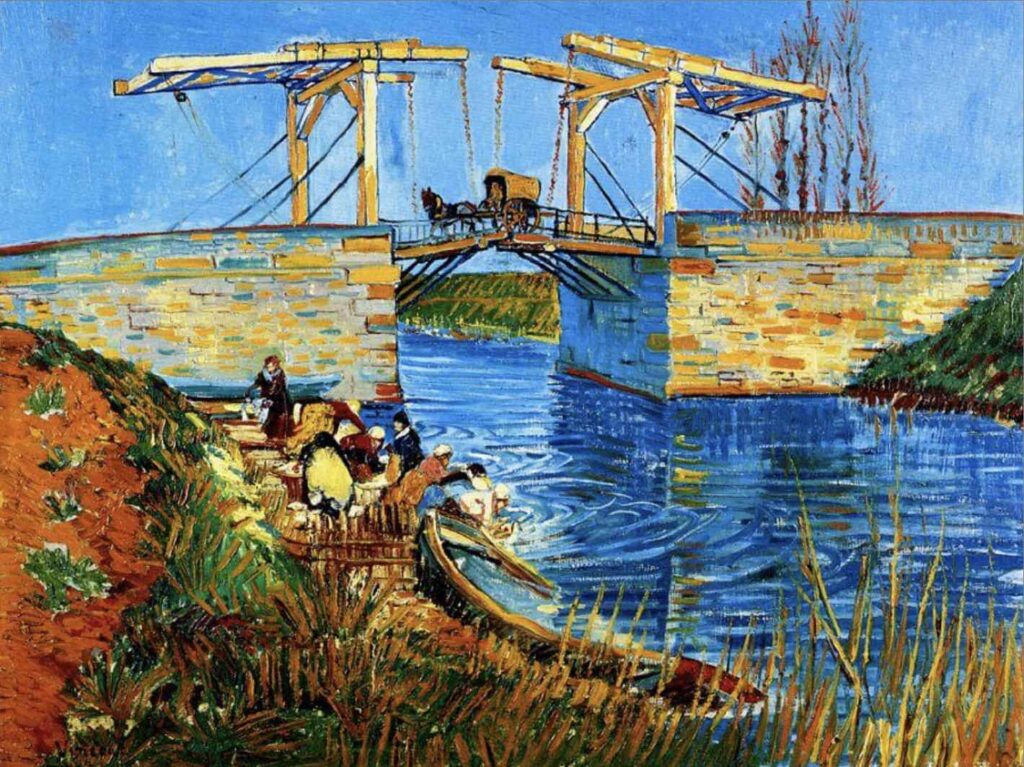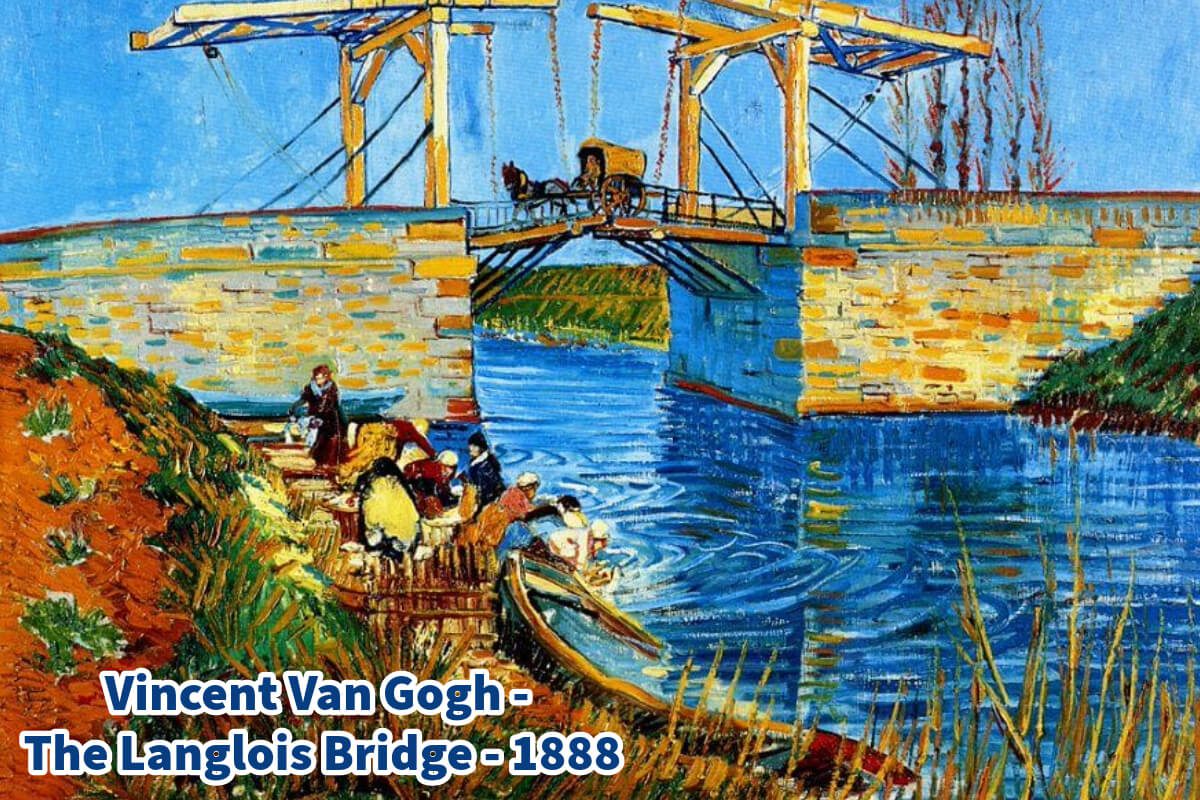Vincent van Gogh holds a special place among my favorite artists. His distinctive use of brushstrokes and colors never fails to captivate me.
While some of his works, like “The Langlois Bridge – 1888,” may be lesser-known than many other Van Gogh paintings, the painting offers a unique perspective into van Gogh’s life during a pivotal period. This artwork provides a glimpse into his surroundings during a crucial juncture in his artistic journey. Read on as we delve deeper into this painting to better understand the world Van Gogh was showing us with this artwork.
Table of Contents
- The Langlois Bridge By Vincent Van Gogh: A Glimpse Into Artistry And Life
- The Langlois Bridge – A Glimpse Into Van Gogh’s World
- Related Questions
The Langlois Bridge By Vincent Van Gogh: A Glimpse Into Artistry And Life
Vincent Van Gogh, one of the most celebrated artists in history, left a legacy of breathtaking artworks that continue to captivate and inspire people worldwide. Among his numerous masterpieces,

“The Langlois Bridge at Arles with Women Washing” is a testament to his genius. This evocative painting showcases Van Gogh’s artistic prowess and provides a glimpse into the life and times of the artist himself. As we delve into this iconic artwork, we will explore the setting, composition, and historical significance of “The Langlois Bridge” while unraveling its story.
The Grey Sky Of Arles: A Painter’s Inspiration
Imagine a grey, overcast sky looming over the picturesque landscape of Arles, a southern French city that Vincent Van Gogh called home during a significant period of his life. In this tranquil yet vibrant setting, Van Gogh created “The Langlois Bridge.”
Rather than deterring him, the grey sky inspired his artistic expression, providing a unique atmosphere to his work.
Van Gogh’s decision to work in the open air in Arles was not uncommon for him. He frequently ventured outdoors to capture the essence of his surroundings, a practice known as plein-air painting. In the case of “The Langlois Bridge,” the natural lighting and surroundings played a crucial role in shaping the artwork’s mood and character.

Life Along The Canal
“The Langlois Bridge” depicts a serene scene along a canal in Arles. Here, the locals went about their daily lives, and one of the striking features of the painting is the presence of laundry being done in the canal.
Linens in various shades of white have been laid out on the far bank, contrasting the muted grey of the sky. This seemingly ordinary scene takes on new life through Van Gogh’s brushstrokes.
One element initially included in an earlier version of the painting but is conspicuously missing in this rendition is the washerwomen themselves. Their absence allows viewers to imagine the toil and camaraderie of these women who once graced the canal’s banks.
Van Gogh’s choice to omit them in this version leaves room for interpretation, allowing us to focus on the landscape and the bridge itself.
Composition: A Glimpse Into Van Gogh’s Artistic Mind
One of the most intriguing aspects of “The Langlois Bridge” is its composition. Van Gogh meticulously organized the elements within the frame to create a visually compelling narrative. He strategically placed his easel to capture a patch of land with a road in the foreground, which extends as a sizeable diagonal leading into the left background of the painting.
This compositional technique was influenced by Van Gogh’s exposure to Japanese prints, a collection he and his brother Theo had acquired during their time in Paris. Japanese art profoundly impacted the development of Van Gogh’s style, and he drew inspiration from their use of diagonals to create depth and movement within their compositions.
The diagonal road in “The Langlois Bridge” serves as a dynamic element, drawing the viewer’s eye into the heart of the painting. Flanked by trees and shrubbery, this road adds perspective and depth to the scene. The contrast between the road’s warm tones and the calm, grey sky intensifies the emotional impact of the artwork.
Provenance: A Journey Through Time
The journey of “The Langlois Bridge” doesn’t end with the strokes of Van Gogh’s brush. Like many of Van Gogh’s works, this painting has a rich ownership and exhibition history. It was initially sent by the artist from Arles to his brother Theo van Gogh in Paris at the beginning of May 1888. The painting became part of his legacy after Vincent’s untimely death on 25 January 1891.
Theo’s widow, Jo van Gogh-Bonger, and their son, Vincent Willem van Gogh, inherited the artwork. Jo took on the responsibility of administering the collection and caring for her late brother-in-law’s artistic legacy. She played a crucial role in preserving and promoting Van Gogh’s work, ensuring it would continue inspiring future generations.
Over the years, “The Langlois Bridge” found its way into various exhibitions and collections. Vincent Willem van Gogh lent the painting to the Stedelijk Museum in Amsterdam on 22 October 1931. This temporary loan began the painting’s journey through different institutions.
In a significant turn of events, Vincent Willem van Gogh transferred the artwork to the Vincent van Gogh Foundation in Amsterdam on 10 July 1962. This decision paved the way for an agreement between the foundation and the State of the Netherlands.
Today, “The Langlois Bridge at Arles with Women Washing” is on permanent loan to the Rijksmuseum Vincent van Gogh and is a cherished part of the Van Gogh Museum’s collection, where it continues to captivate art enthusiasts and provide insight into the artist’s life and creative process.
The Langlois Bridge – A Glimpse Into Van Gogh’s World
“The Langlois Bridge at Arles with Women Washing” by Vincent Van Gogh is not just a painting; it’s a portal to a specific moment in the artist’s life and the world he inhabited. The grey sky that looms over the canvas, the serene canal, and the absence of washerwomen all contribute to the painting’s enigmatic charm.
Van Gogh’s meticulous composition, influenced by his appreciation of Japanese art, elevates the work to a masterpiece. Diagonals and the interplay of warm and cool tones create a visual experience that transcends the ordinary.

The provenance of “The Langlois Bridge” tells a story of dedication and preservation. From Vincent’s initial gift to his brother Theo to Jo van Gogh-Bonger’s tireless efforts in preserving his legacy, the journey of this painting is a testament to the enduring power of art.
Today, as “The Langlois Bridge” graces the walls of the Rijksmuseum Vincent van Gogh, it continues to inspire and evoke emotions in those who gaze upon it. It serves as a bridge not only to Van Gogh’s world but also to the timeless beauty of art that transcends generations.
In the end, “The Langlois Bridge” reminds us that art has the power to capture moments, emotions, and stories that endure long after the artist’s brush has touched the canvas. It invites us to explore the grey skies and serene canals of Arles through Van Gogh’s eyes, inviting us into the world of a tormented yet brilliant artist whose work continues to resonate with the world.
Anita Louise Art is dedicated to art education, great artists, and inspiring others to find and create their art. We love art that uplifts and inspires. #ArtToMakeYouSmile! #ArtToMakeYouHappy!
If you want to see any of my art, you can find out more by clicking here. If you are interested in what inspires me and my paintings, you can discover more by clicking here.
We have a free newsletter and would love you to be part of our community; you can subscribe to the newsletter by clicking here. If you have any questions, I would be happy to talk to you anytime. You can reach me, Anita, by clicking here.
Subscribe to our Anita Louise Art YouTube Channel with great videos and information by clicking here.
Join us for our podcast “5 Minutes With Art.” Spend just 5 minutes a week with us to discover and learn about great art and artists. You can find out more about our podcast by clicking here.
Related Questions
How Was Leonardo da Vinci Able To Master So Many Different Professions?
Leonardo da Vinci is a man known to have had many different titles and professions during his lifetime. He was able to master this profession because he was a genius. But more than just being a genius, Leonardo is also self-educating and never stops learning. He had an insatiable amount of curiosity about all kinds of subjects.
By clicking here, you can learn more by reading How Was Leonardo da Vinci Able To Master So Many Different Professions?
What Can We Learn From Leonardo Da Vinci?
Leonardo da Vinci was a philosopher; being a philosopher means that you want to seek wisdom. Leonardo was one person who tried to seek knowledge or enlightenment in his life. Leonardo was an active observer and learner of the human body, human behavior, and nature.
By clicking here, you can learn more by reading What Can We Learn From Leonardo Da Vinci?
Was Leonardo da Vinci A Philosopher?
Leonardo da Vinci was a philosopher; being a philosopher means that you want to seek wisdom. Leonardo was one person who tried to seek knowledge or enlightenment in his life. Leonardo was an active observer and learner of the human body, human behavior, and nature.
By clicking here, you can learn more by reading Was Leonardo da Vinci A Philosopher?

